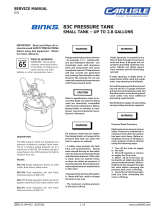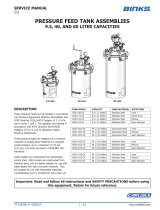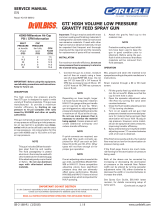Page is loading ...

INSTALLATION MANUAL
77-3159-R2 (03/2023) 1/14 www.carlisleft.com
EN
Screen Protector Kit
240-5143 (RM2)
310-8030 (RF2)
Scan the related QR code above for other languages
of this Screen Protector Kit installation manual and
additional product information.

EN
77-3159-R2 (03/2023) 2/14 www.carlisleft.com
CONTENTS
CONTENTS
SAFETY 3-7
Safety Precautions ............................................................................................................................................ 3
Hazards/Safeguards ........................................................................................................................................4-7
INTRODUCTION 8
Screen Protector Introduction ............................................................................................................................. 8
INSTALLATION 9-15
Install Screen Protector .................................................................................................................................9-11
Air Pocket Removal ..........................................................................................................................................12
Protective Layer Removal ................................................................................................................................. 12
MANUAL CHANGE SUMMARY 13
Manual Revisions .............................................................................................................................................13
WARRANTY 14
Warranty .........................................................................................................................................................14

77-3159-R2 (03/2023)3/14www.carlisleft.com
EN
SAFETY
The hazards shown on the following pages may
occur during the normal use of this equipment.
WARNING!: Indicates a hazardous situation that, if
not avoided, could result in death or serious injury.
Caution!: Indicates a hazardous situation that, if
not avoided, could result in minor or moderate
injury or equipment damage.
Notice: Indicates information considered important
but not hazard related.
SAFETY PRECAUTIONS
Before operating, maintaining or servicing any
electrostatic coating system, read and understand all
of the technical and safety literature for your products.
This manual contains information that is important for
you to know and understand. This information relates
to USER SAFETY and PREVENTING EQUIPMENT
PROBLEMS.
To help you recognize this information, we use the
following symbols. Please pay particular attention to
these sections.
While this manual lists standard specications and
service procedures, some minor deviations may be
found between this literature and your equipment.
Dierences in local codes and plant requirements,
material delivery requirements, etc., make such
variations inevitable. Compare this manual with
your system installation drawings and associated
equipment manuals to reconcile such dierences.
Careful study and continued use of this manual will
provide a better understanding of the equipment
and process, resulting in more ecient operation,
longer trouble-free service and faster, easier
troubleshooting. If you do not have the manuals and
safety literature for your equipment, contact your local
Carlisle Fluid Technologies representative or Carlisle
Fluid Technologies technical support.
SAFETY
Repairs may only be performed by personnel
authorized by Carlisle Fluid Technologies.
The user MUST read and be familiar with the
Safety Section in this manual and the safety
literature therein identied.
This equipment is intended to be used by trained
personnel ONLY.
This manual MUST be read and thoroughly
understood by ALL personnel who operate, clean
or maintain this equipment! Special care should be
taken to ensure that the WARNINGS and safety
requirements for operating and servicing the
equipment are followed.
The user should be aware of and adhere to ALL
local building and re codes and ordinances as
well as NFPA 33 AND EN 16985 SAFETY
STANDARDS, LATEST EDITION, or applicable
country safety standards, prior to installing,
operating, and/or servicing this equipment.

EN
77-3159-R2 (03/2023) 4/14 www.carlisleft.com
AREA
Tells where hazards
may occur
HAZARDS
Tells what the hazard is SAFEGUARDS
Tells how to avoid the hazard
Spray Area Fire Hazard
Improper or inadequate
operation and maintenance
procedures will cause a re
hazard.
Protection against
inadvertent arcing that
is capable of causing
re or explosion is lost if
any safety interlocks are
disabled during operation.
Frequent Power Supply
or Controller shutdown
indicates a problem in the
system requiring correction.
Fire extinguishing equipment must be present in
the spray area and tested periodically.
Spray areas must be kept clean to prevent the
accumulation of combustible residues.
Smoking must never be allowed in the spray area.
The high voltage supplied to the atomizer must
be turned o prior to cleaning, ushing, or
maintenance.
Spray booth ventilation must be kept at the rates
required by NFPA 33, EN 16985, country, and local
codes. In addition, ventilation must be maintained
during cleaning operations using ammable or
combustible solvents.
Electrostatic arcing must be prevented. Safe
sparking distance must be maintained between the
parts being coated and the applicator. A distance of
1 inch (25mm) for every 10KV of output voltage is
required at all times.
Test only in areas free of combustible material.
Testing may require high voltage to be on, but only
as instructed.
Non-factory replacement parts or unauthorized
equipment modications may cause re or injury.
If used, the key switch bypass is intended for use
only during setup operations. Production should
never be done with safety interlocks disabled.
The paint process and equipment should be set up
and operated in accordance with NFPA 33, NEC,
OSHA, local, country, and European Health and
Safety Norms.
SAFETY

77-3159-R2 (03/2023)5/14www.carlisleft.com
EN
AREA
Tells where the
hazard may occur
HAZARD
Tells what the hazard is SAFEGUARDS
Tells how to avoid the hazard
Spray Area Explosion Hazard
Improper or inadequate
operation and maintenance
procedures will cause a re
hazard.
Protection against
inadvertent arcing that
is capable of causing
re or explosion is lost if
any safety interlocks are
disabled during operation.
Frequent Power Supply
or Controller shutdown
indicates a problem in the
system requiring correction.
Electrostatic arcing must be prevented. Safe
sparking distance must be maintained between the
parts being coated and the applicator. A distance
of 1 inch (25mm) for every 10KV of output voltage
is required at all times.
Unless specically approved for use in hazardous
locations, all electrical equipment must be located
outside or applicable county code hazardous areas,
in accordance with NFPA 33.
Test only in areas free of ammable or combustible
materials.
The current overload sensitivity (if equipped)
MUST be set as described in the related section
of the equipment manual. Protection against
inadvertent arcing that is capable of causing re or
explosion is lost if the current overload sensitivity
is not properly set. Frequent power supply
shutdown indicates a problem in the system which
requires correction.
Always turn the control panel power o prior to
ushing, cleaning, or working on spray system
equipment.
Before turning high voltage on, make sure no
objects are within the safe sparking distance.
Ensure that the control panel is interlocked with
the ventilation system and conveyor in accordance
with NFPA-33, EN 16985.
Have re extinguishing equipment readily available
and tested periodically.
General Use and
Maintenance Improper operation or
maintenance may create a
hazard.
Personnel must be properly
trained in the use of this
equipment.
Personnel must be given training in accordance with
the requirements of NFPA 33.
Instructions and safety precautions must be read
and understood prior to using this equipment.
Comply with appropriate local, state, and national
codes governing ventilation, re protection,
operation maintenance, and housekeeping.
Reference OSHA, NFPA 33, EN Norms and your
insurance company requirements.
SAFETY

EN
77-3159-R2 (03/2023) 6/14 www.carlisleft.com
SAFETY
AREA
Tells where the
hazard may occur
HAZARD
Tells what the hazard is SAFEGUARDS
Tells how to avoid the hazard
Spray Area /
High Voltage
Equipment
Electrical Discharge
There is a high voltage device
that can induce an electrical
charge on ungrounded objects
which is capable of igniting
coating materials.
Inadequate grounding will
cause a spark hazard. A
spark can ignite many coating
materials and cause a re or
explosion.
Parts being sprayed and operators in the spray area must
be properly grounded.
Parts being sprayed must be supported on conveyors
or hangers that are properly grounded. The resistance
between the part and earth ground must not exceed 1
Meg Ohm. (Refer to NFPA 33, EN 16985.)
Operators must be grounded. Grounding straps on wrists
or legs may be used to assure adequate ground contact.
Footware to be used by operator shall comply with EN
ISO 20344, resistance not to exceed 100 Meg Ohm.
Protective clothing including gloves should comply with
EN 1149-5, resistance not to exceed 100 Meg Ohm.
Operators must not be wearing or carrying any
ungrounded metal objects.
When using an electrostatic handgun, operators must
assure contact with the handle of the applicator via
conductive gloves or gloves with the palm section cut
out.
NOTE: REFER TO NFPA 33, EN 16985 OR SPECIFIC
COUNTRY SAFETY CODES REGARDING PROPER
OPERATOR GROUNDING.
All electrically conductive objects in the spray area, with
the exception of those objects required by the process
to be at high voltage, must be grounded. Grounded
conductive ooring must be provided in the spray area.
Always turn o the power supply prior to ushing,
cleaning, or working on spray system equipment or
applicable county code.
Unless specically approved for use in hazardous
locations, all electrical equipment must be located
outside or applicable country code, hazardous areas, in
accordance with NFPA 33.
Avoid installing an applicator into a uid system where
the solvent supply is ungrounded.
Do not touch the applicator electrode while it is
energized.

77-3159-R2 (03/2023)7/14www.carlisleft.com
EN
SAFETY
AREA
Tells where the
hazard may occur
HAZARD
Tells what the hazard is SAFEGUARDS
Tells how to avoid the hazard
Electrical
Equipment Electrical Discharge
High voltage equipment is
utilized in the process. Arcing
in the vicinity of ammable
or combustible materials may
occur. Personnel are exposed
to high voltage during
operation and maintenance.
Protection against inadvertent
arcing that may cause a re
or explosion is lost if safety
circuits are disabled during
operation.
Frequent power supply shut-
down indicates a problem in
the system which requires
correction.
An electrical arc can ignite
coating materials and cause a
re or explosion.
Unless specically approved for use in hazardous
locations, the power supply, control cabinet, and all
other electrical equipment must be located outside or
applicable country codes, hazardous areas in accordance
with NFPA 33 and EN 16985.
Turn the power supply OFF before working on the
equipment.
Test only in areas free of ammable or combustible
material.
Testing may require high voltage to be on, but only as
instructed.
Do no production with disabled safety circuits.
Before turning the high voltage on, make sure no objects
are within the sparking distance.
Toxic Substances Chemical Hazard
Certain materials may be
harmful if inhaled, or if there
is contact with the skin.
Follow the requirements of the Safety Data Sheet
supplied by coating material manufacturer.
Adequate exhaust must be provided to keep the air
free of accumulations of toxic materials. Reference EN
12215 or applicable code.
Use a mask or respirator whenever there is a chance
of inhaling sprayed materials. The mask must be
compatible with the material being sprayed and its
concentration. Equipment must be as prescribed by
an industrial hygienist or safety expert, and be NIOSH
approved.
Spray Area Explosion Hazard -
Incompatible Materials
Halogenated hydrocarbon
solvents for example:
Methylene chloride and 1,1,1,
- Trichloroethane are not
chemically compatible with the
aluminum that might be used
in many system components.
The chemical reaction caused
by these solvents reacting
with aluminum can become
violent and lead to an
equipment explosion.
Spray applicators require that aluminum inlet ttings be
replaced with stainless steel.
Aluminum is widely used in other spray application
equipment - such as material pumps, regulators,
triggering valves, etc. Halogenated hydrocarbon solvents
must never be used with aluminum equipment during
spraying, ushing, or cleaning. Read the label or data
sheet for the material you intend to spray. If in doubt
as to whether or not a coating or cleaning material is
compatible, contact your coating supplier. Any other type
of solvent may be used with aluminum equipment.

EN
77-3159-R2 (03/2023) 8/14 www.carlisleft.com
INTRODUCTION
The screen protector kit is designed to protect the HMI screen of IntelliFlow systems from scratches, dust,
and smudges. The screen protector comprises three-layers of a protective lm and one release liner layer.
The release liner is removed during installation, and each of the three protective lm layers can be removed
individually as the screen protector becomes scratched, marred, or damaged.
This manual describes how to install and use the screen protector for the RM2 and RF2. Make sure to order
the correct kit for your component material proportioner.
RM2 OR RF2 SCREEN PROTECTOR KIT CONTENTS
No. Part No. Description Qty.
Notes
1 240-5143
RM2 Three-layer lm HMI screen protector (shown)
1
10” 3-Layer
1 310-8030
RF2 Three-layer lm HMI screen protector (not shown)
1
15” 3-Layer
2 N/A Hand Applicator 1 Included in Kit
3 N/A Sterile Alcohol Prep Pad 1 Included in Kit
4 N/A Pre-moistened Lens Cleaning Towlette 1 Included in Kit
5 N/A Layer Separator 1 Included in Kit
1
2
543
INTRODUCTION

77-3159-R2 (03/2023)9/14www.carlisleft.com
EN
INSTALLATION
Read these instructions before you install the screen protector on the RF2 or RM2 HMI screen. For best
results, install the screen protector only in an environment free from wind and dust particles.
INITIAL SCREEN CLEANING
1. Remove any lms, tapes, decals, or other
materials from the HMI screen.
2. Use the sterile alcohol prep pad (3) to wipe the
screen completely clean of ngerprints, smudges,
dirt, adhesive, and dust.
SCREEN PROTECTOR INSTALLATION
1. Look at the screen protector (1) and place the side with the “Remove Release Liner This Side” label face
pointed up, which will be applied to the screen.
2. Carefully peel o about an inch of the release liner from a corner of the screen protector.
• The three-layer lm screen protector has one release liner and three protective layers.
There must be no remaining particles on the
screen after it has been cleaned. Such particles will
be trapped under the protector and will cause air
pockets that prevent complete screen adhesion. 3
5
1
INSTALLATION

EN
77-3159-R2 (03/2023) 10/14 www.carlisleft.com
3. Make sure all dust and dirt particles are removed.
Use the pre-moistened lens cleaning towelette (4)
and wipe the screen again. Allow the HIM screen
to dry completely.
4. Align the screen protector with the top edge of
the HMI screen, as shown in red. Position the
exposed corners of the screen protector to the
corner of the screen as circled in yellow.
• The release liner is thinner than the vs of protective lm. Remove only the release liner.
• Do not touch the exposed side of the screen protector that will contact the screen.
The screen protector can be placed on a clean and at surface to help remove a dicult release layer. The
layer separator tool (5) can separate and lift the release liner.
4
INSTALLATION
1

77-3159-R2 (03/2023)11/14www.carlisleft.com
EN
5. When the screen protector is positioned on the
HMI screen, carefully push down the exposed
edges to make contact. Use the hand applicator
(2) to promote adhesion alignment.
6. Gradually peel and pull down the release liner.
While it is peeled away, push the screen protector
against the HMI screen.
7. Lightly push the screen protector down with the
hand applicator to promote adhesion and prevent
possible trapped air bubbles.
INSTALLATION
2

EN
77-3159-R2 (03/2023) 12/14 www.carlisleft.com
AIR POCKET REMOVAL
Air pockets can appear under the screen protector
after installation. These air pockets can be easily
removed if no dust is trapped between the screen
protector and the HMI screen.
1. To start, put the hand applicator (2) in the center
of the screen protector and apply moderate
pressure to the screen protector.
2. Push the trapped air pockets away from the
center of the screen protector in the direction of
the nearest edge.
3. Repeat this procedure until there are no more
trapped air bubbles.
PROTECTIVE LAYER
REMOVAL
The screen protector has three-layers that can
be removed separately as the screen protector
becomes scratched or damaged over time.
1. Use the layer separator tool (5) to remove the
damaged outer layer from the screen protector.
2. Push the thin end of the layer separator tool
against the corner of the screen protector until
the separator tool lifts the protective top layer.
3. Carefully peel the top protective layer away from
the screen protector. Discard the old peeled layer.
INSTALLATION
5

77-3159-R2 (03/2023)13/14www.carlisleft.com
EN
MANUAL REVISIONS
MANUAL REVISIONS
Date
Rev
Description
12/01/2022 R1 Initial release
03/20/2023 R2 Revised and added images
MANUAL REVISION SUMMARY

WARRANTY POLICY
This product is covered by Carlisle Fluid Technologies’ materials and workmanship limited warranty.
The use of any parts or accessories, from a source other than Carlisle Fluid Technologies, will void all
warranties.
Failure to reasonably follow any maintenance guidance provided, may invalidate any warranty.
For specific warranty information please contact Carlisle Fluid Technologies.
For technical assistance or to locate an authorized distributor, contact one of our international sales
and customer support locations.
For the latest information about our products, visit www.carlisleft.com.
Carlisle Fluid Technologies is a global leader in innovative finishing technologies.
Carlisle Fluid Technologies reserves the right to modify equipment specifications without prior notice.
BGKTM, Binks®, DeVilbiss®, Hosco®, MS®, and Ransburg®
are registered trademarks of Carlisle Fluid Technologies, Inc.
©2022 Carlisle Fluid Technologies, Inc.
All rights reserved.
Tel: +44 (0)1202 571 111
Fax: +44 (0)1202 573 488
Tel: +8621-3373 0108
Fax: +8621-3373 0308
Tel: +81 45 785 6421
Fax: +81 45 785 6517
Tel: +61 (0) 2 8525 7555
Fax: +61 (0) 2 8525 7575
Region
Americas
Europe, Africa
Middle East, India
China
Japan
Australia
Industrial / Automotive
Tel: 1-800-992-4657
Fax: 1-888-246-5732
Automotive Renishing
Tel: 1-800-445-3988
Fax: 1-800-445-6643
16430 North Scottsdale Rd.
Scottsdale, AZ 85254 USA
EN
77-3159-R2 (03/2023) 14/14 www.carlisleft.com
WARRANTY
/








